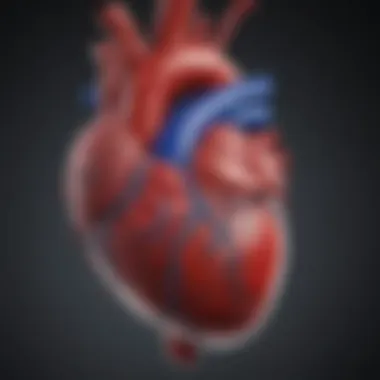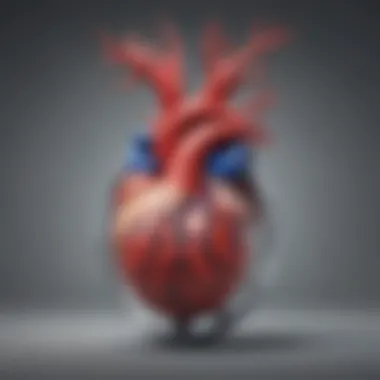Effective Approaches to Prevent Heart Valve Disease


Intro
Heart valve disease is a silent disruptor, often creeping in unnoticed until it becomes a significant issue. Millions around the world bear its weight, which complicates the efficiency of blood flow within the heart. Understanding the intricacies surrounding this condition is crucial for those in the medical field and beyond. Prevention, being a cornerstone of healthcare, must be prioritized to lower the occurrence of heart valve disease.
The modern lifestyle, marked by high-stress levels, poor diets, and sedentary habits, contributes heavily to the risk factors associated with heart valve disease. As such, a comprehensive approach to prevention must commence at the grassroots level—a focus on significant lifestyle modifications along with informed medical intervention. In this article, we shall delve into various strategies aimed at preventing heart valve disease, shedding light on the importance of early detection and innovative medical techniques. This foundational understanding will enhance knowledge among students, researchers, educators, and professionals, promoting an empowered community ready to take proactive measures in the face of this health challenge.
Research Context
Background Information
Heart valves play a pivotal role by regulating blood flow within the heart chambers. When they become damaged or diseased, the mechanics of blood circulation are compromised, leading to a plethora of health issues. Common causes of heart valve problems include congenital defects, infections such as rheumatic fever, and age-related changes. The earlier one comprehends the risks and symptoms, the earlier measures can be taken to mitigate them.
Studies indicate that lifestyle factors—like obesity, smoking, and hypertension—continue to surge in frequency, especially in younger demographics, which raises an eyebrow regarding their long-term health outcomes.
Importance of the Study
This examination of preventive strategies seeks to address an ever-growing problem. With heart valve disease ranking among the leading causes of morbidity, understanding its prevention holds vast implications for public health.
The potential to impact a significant swath of the population necessitates an urgent conversation around modifiable risk factors and the advancement of medical interventions. Heart valve disease isn't just a concern for a specific demographic; it ranges across age groups and genders, underscoring a stark need for education and awareness.
"Preventing heart valve disease is not merely a personal concern; it extends into the very well-being of communities across the globe."
Discussion
Interpretation of Results
Research shows that individuals who engage in regular physical activity, maintain a balanced diet rich in fruits and vegetables, and avoid smoking are considerably less likely to develop heart valve disease. The link is clear: lifestyle choices carry weight in fostering or hindering heart health. Furthermore, the integration of regular medical check-ups into one’s routine can lead to early detection of potential issues, allowing for timely intervention.
Comparison with Previous Research
Previous studies have pointed out similar findings where lifestyle modifications serve as a robust defense against heart-related ailments. However, this article aims to synthesize newer data and highlight specific strategies that have emerged in recent years. The development of state-of-the-art imaging techniques for better diagnosis and enhanced surgical methods for valve repair and replacement offers hope. It brings into focus a dual strategy: combining personal responsibility with advanced medical solutions.
Understanding Heart Valve Disease
Heart valve disease represents a significant concern in cardiovascular health, impacting millions and often leading to serious complications if not addressed early. Understanding this condition is crucial because it allows individuals and health professionals to implement effective preventative strategies. Knowledge of heart valve disease sheds light on its nature, types, symptoms, and how they influence blood circulation, ultimately promoting better health outcomes.
Definition and Types of Heart Valve Disorders
Heart valve disorders occur when one or more of the heart's four valves—mitral, aortic, tricuspid, and pulmonary—fail to operate correctly. These valves have specific functions, ensuring blood flows in the right direction through the heart and to the rest of the body.
There are two main categories of heart valve disorders:
- Stenosis: This condition occurs when a valve narrows, limiting blood flow. A typical example is aortic stenosis, where the aortic valve does not fully open.
- Regurgitation: This happens when a valve doesn't close properly, causing blood to flow backward into the heart chambers. Mitral regurgitation is a common form of this disorder.
Anatomy of the Heart Valves
Understanding the anatomy of heart valves lays the groundwork for grasping how they function. Each valve consists of flaps called leaflets or cusps that open and close to control blood flow.
- The Mitral Valve, located between the left atrium and left ventricle, has two leaflets. It facilitates blood flow from the atrium to the ventricle.
- The Aortic Valve, with three cusps, sits between the left ventricle and the aorta, ensuring oxygenated blood moves into the systemic circulation.
- The Tricuspid Valve, having three leaflets, regulates blood flow from the right atrium to the right ventricle.
- The Pulmonary Valve, like the aortic valve, has three cusps, controlling blood flow from the right ventricle into the pulmonary artery.
Understanding these structures helps in identifying which valves may be affected and the implications for overall heart function.
Common Symptoms Associated with Heart Valve Disease
Being aware of the symptoms associated with heart valve disease can enhance early detection and intervention. Patients may experience a range of symptoms including:
- Fatigue: A common sign, indicating the heart may struggle to pump sufficient blood.
- Shortness of Breath: This can occur during daily activities or even at rest, often caused by fluid buildup in the lungs.
- Palpitations: People may notice irregular heartbeats or a fluttering sensation in the chest.
- Swelling: Fluid retention in the legs, ankles, or abdomen can signal issues with heart valves.
- Chest Pain: Although less common, this symptom may indicate a serious condition and warrants immediate medical attention.
"Early recognition of symptoms is key in preventing the progression of heart valve diseases, ensuring timely medical intervention can be applied."
Ultimately, a sound understanding of the heart's valves, their disorders, and associated symptoms empowers individuals to seek medical advice promptly, laying the groundwork for effective prevention and management.
Risk Factors Contributing to Heart Valve Disease
When it comes to heart valve disease, understanding the risk factors is equivalent to having an ace up your sleeve. It’s about unearthing the roots of the problem before the tree grows too tall. This section delves into genetic, demographic, and behavioral aspects that can pave the way for heart valve issues.


Genetic Predisposition
Genetics play a pivotal role in the likelihood of developing heart valve disease. It’s like being dealt a hand of cards in a game where some players have more favorable cards right from the start. If your family history is peppered with heart problems, your chances increase significantly. Conditions such as connective tissue disorders, like Marfan syndrome or Ehlers-Danlos syndrome, can lead to valve abnormalities.
Key takeaway: If heart disease runs in your family, it’s wise to be particularly vigilant about heart health. Regular check-ups can be crucial.
Age and Gender Considerations
As we age, the wear and tear on our body's systems naturally intensifies. Heart valves are no different. Older adults face a higher risk of degenerative diseases, making age a major player here. We also can't ignore gender; studies have shown variances in valve disease prevalence between men and women. For instance, men typically have a higher risk of developing aortic stenosis, while women are more prone to mitral valve prolapse, especially after they go through menopause.
- Age Impacts: The risk increases significantly for those above 65.
- Gender Disparities: Men tend to experience symptoms earlier than women, though women may face greater complications later in life.
Lifestyle Choices and Their Impact
The choices we make day in and day out can cast long shadows on our heart health. Lifestyle factors such as diet, physical activity, smoking, and alcohol consumption must be taken into account. An unhealthy diet rich in saturated fats can wreak havoc on our cardiovascular system, while lack of exercise can weaken the heart muscle, leading to inefficiencies in blood flow. On the other hand, adopting a heart-healthy diet—think Mediterranean, filled with fruits, veggies, whole grains, and lean proteins—can do wonders.
- Negative Impact of Choices:
- Positive Changes:
- Smoking: Damages blood vessels and valves.
- Excessive Alcohol: Can lead to high blood pressure and irregular heartbeats.
- Regular Exercise: Keeps the heart strong and valves functioning.
- Balanced Diet: Supports overall heart health.
Identifying and understanding these risk factors is crucial to devising tailored strategies to mitigate them. It’s a balanced blend of awareness, education, and proactive measures that can pave the way for preventing heart valve disease effectively.
Preventive Lifestyle Modifications
Preventive lifestyle modifications are the bedrock of any effective strategy aimed at reducing the risk of heart valve disease. This complex condition can sneak up on people, often going unnoticed until it becomes severe. By adopting healthier lifestyle choices, individuals can significantly diminish their chances of developing heart valve problems. These modifications not only enhance heart health but also contribute to overall well-being.
Nutritional Guidelines for Heart Health
One of the foremost lines of defense against heart valve disease lies in what we eat. Nutritional choices can make or break heart health. To support optimal heart function, focusing on a diet rich in heart-healthy foods is essential. This includes:
- Fruits and Vegetables: These should take center stage, as they are packed with antioxidants and fiber, helping to maintain blood pressure and reduce cholesterol levels.
- Whole Grains: Opt for whole wheat bread, brown rice, and oats, which provide essential nutrients and help manage weight.
- Lean Proteins: Fish, especially fatty types like salmon or mackerel, introduces omega-3 fatty acids beneficial for heart health. Chicken and legumes can also serve as excellent protein sources without excessive saturated fats.
- Healthy Fats: Incorporate monounsaturated fats from sources like avocados, nuts, and olive oil while avoiding trans and saturated fats found in processed foods.
Understanding portion sizes is equally important. Overeating can lead to weight gain and increase the risk of developing heart valve issues. It’s not just about what’s on the plate but how much of it fills the plate.
Importance of Physical Activity
Staying active isn’t just about burning calories; it’s about nurturing the heart. Regular physical activity not only helps keep the weight in check but also strengthens the heart muscle and improves circulation. Studies indicate that engaging in at least 150 minutes of moderate-intensity aerobic exercise per week can provide substantial cardiovascular benefits. This can be achieved through:
- Walking or Jogging: Simple activities like brisk walking or jogging can go a long way toward improving heart health. Even short bursts of activity throughout the day can be beneficial.
- Swimming: This low-impact exercise is great for people of all ages and can significantly boost heart function while being gentle on the joints.
- Strength Training: Building muscle through resistance exercises helps enhance metabolism and maintain a healthy weight.
Incorporating movement into daily routines—like taking the stairs instead of the elevator or cycling to work—can make a marked difference over time.
Managing Stress Effectively
In today’s fast-paced world, stress management is more crucial than ever in safeguarding against heart valve disease. Chronic stress can lead to elevated blood pressure and other adverse effects on heart health. It’s a good idea to explore different stress-reduction techniques such as:
- Mindfulness and Meditation: Practicing mindfulness or meditation can help calm the mind, lower stress, and improve overall emotional well-being.
- Yoga: This ancient practice combines physical activity with breath control and mindfulness, which has been shown to reduce stress and improve heart health.
- Social Connections: Building and nurturing relationships with family and friends can provide support systems crucial for managing stress.
In addition, having hobbies or engaging in activities that bring joy and relaxation can alleviate stress levels, contributing to a healthier heart. As the saying goes, "a healthy heart leads to a happy life."
Preventive lifestyle modifications encompass a holistic approach towards heart valve disease. They empower individuals, enabling them to take charge of their heart health proactively. In the subsequent sections, we will delve deeper into how regular medical check-ups and screenings further bolster these preventive strategies.
The Role of Regular Check-ups and Screenings
Regular check-ups and screenings are critical in the realm of heart health, particularly related to the prevention of heart valve disease. Healthcare professionals often emphasize how early detection can serve as a frontline defense against complications that arise from undiagnosed conditions. Rather than waiting for symptoms to manifest themselves, patients are encouraged to adopt a proactive stance towards their heart health. This approach not only aids in identifying issues at an incipient stage but also helps in tailoring personalized management strategies.
Understanding Cardiac Assessments
Cardiac assessments encompass a range of diagnostic tests designed to evaluate the heart's structure and function. These assessments might include physical examinations where the physician listens to heart sounds or reviews medical history for red flags. More sophisticated measures, such as blood tests and imaging studies, provide a deeper insight into cardiovascular health. While a general check-up cannot reveal detailed valve dysfunction, it acts as a pathway to more specialized examinations and ultimately supports early intervention.
Key Components of Cardiac Assessments:
- Family and personal medical history
- Blood pressure readings
- Physical examination of heart sounds
- Blood tests for cholesterol and other risk factors
- Referrals for specialized tests, if necessary
The results of these assessments equip healthcare providers to recommend necessary lifestyle modifications or medical interventions. A timely assessment could very well deter the advance of heart valve disease in individuals who may not even be aware they are at risk.


Importance of Echocardiograms
Echocardiograms stand as a cornerstone of cardiac diagnostics. This ultrasound-based test produces visual representations of the heart, enabling cardiologists to observe its size, shape, and functioning. The echocardiogram can specifically illuminate any structural abnormalities in the heart valves, such as stenosis or regurgitation.
"Echocardiograms are akin to a window into the heart's workings; they show how effectively the valves are managing blood flow and can catch problems early."
In many cases, such screenings are recommended for patients with risk factors and even for older adults, regardless of their perceived heart health. Besides serving diagnostic purposes, echocardiograms can provide invaluable information regarding the effectiveness of ongoing treatments, ensuring adjustments can be made based on real-time data.
Utilizing Holter Monitors
Holter monitors offer another layer of insight into the heart's behavior over an extended period, usually 24 to 48 hours. Unlike traditional ECGs conducted in clinics, the Holter monitor is portable. It records everything from heart rate to rhythm while the patient engages in their normal daily activities, allowing for a comprehensive assessment of how the heart reacts under various conditions.
This continuous monitoring plays a particularly vital role in identifying arrhythmias or other anomalies that might contribute to valve disease. Patients often find comfort in knowing their heart's activity is being monitored even while they go about their day-to-day lives.
Benefits of Holter Monitoring:
- Continuous tracking of heart activity
- Insightful data about rhythm fluctuations
- Evaluation of symptoms in real-time
In summary, regular check-ups and screenings stand as essential pillars supporting heart valve disease prevention. They foster early detection of potential risks, ensuring individuals can take informed steps toward preserving their heart health. It’s crucial for everyone, especially those with risk factors, to stay vigilant and engage in routine cardiac assessments.
Medical Interventions for Prevention
Medical interventions play a crucial role in the prevention of heart valve disease. They provide an essential layer for managing risk factors, improving outcomes, and, in some cases, preventing the onset of this condition entirely. Understanding pharmacological approaches, surgical options for high-risk patients, and innovations in regenerative medicine can equip both patients and healthcare professionals in making informed choices about prevention strategies.
Pharmacological Approaches in Management
Pharmacological interventions can be pivotal in managing conditions that contribute to heart valve disease. Medications like antihypertensives can help control blood pressure, a significant risk factor, while anticoagulants can prevent blood clots that might arise from valve irregularities.
- Beta-blockers: These are often prescribed to reduce heart workload and manage arrhythmias.
- ACE inhibitors: Useful in lowering blood pressure and protecting the heart's structure.
- Statins: These help to manage cholesterol levels, reducing the risk of plaque buildup in arteries, which can indirectly affect the heart valves.
Monitoring the effectiveness of these medications through routine assessments is essential. Patients should be encouraged to maintain regular communication with their healthcare providers to adjust treatment as necessary. This approach not only improves medication adherence but also fosters a sense of shared responsibility in managing their heart health.
Surgical Options for High-Risk Patients
For individuals at a high risk of developing heart valve disease, surgical interventions may become necessary. This could range from minimally invasive procedures to more complex surgeries aimed at repairing or replacing faulty valves.
- Valve repair: This conservative option is often preferred when possible, as it tends to have shorter recovery times and fewer complications.
- Valve replacement: In circumstances where repair isn’t feasible, patients may require a mechanical or biological valve replacement. Each type has its own benefits and drawbacks, and the choice often hinges on the patient's lifestyle and life expectancy.
- Transcatheter aortic valve replacement (TAVR): A newer method that allows for valve replacement via a catheter, this option is less invasive and suitable for patients who may not be able to withstand open-heart surgery.
Deciding on a surgical option involves a thorough assessment of the patient's condition, and discussions about potential risks and benefits must be comprehensively covered with the patient.
Innovations in Regenerative Medicine
Regenerative medicine is an exciting area in medical science, with the potential to transform how heart valve disease is approached in terms of prevention and treatment. This field focuses on the body's ability to heal and repair itself, which can be harnessed to improve heart valve function.
Tissue engineering techniques are under investigation, aimed at creating artificial heart valves that can integrate more naturally with the body. Additionally, researchers are exploring stem cell therapies, which could potentially regenerate damaged heart valves or enhance the healing processes of existing ones.
Some of the expected advancements in this arena include:
- Bioengineered valves that promote healthy tissue growth and function.
- Genetic therapy targeting underlying causes of heart valve disease.
As these innovations progress, they may lead to more effective, less invasive treatment options that could significantly alter the landscape of heart valve disease prevention.
The continuous exploration of these medical interventions highlights the evolving nature of heart valve disease management, ultimately aiming to enhance the quality and longevity of life for those at risk.
Patient Education and Awareness
In confronting heart valve disease, the role of patient education and awareness cannot be overstated. Informing patients about the nature of heart valve conditions and the significant impact they can have on overall health is pivotal. Knowledge empowers individuals to take charge of their health, leading to better management practices and proactive choices that can mitigate risks.
Empowering Patients through Knowledge
Empowerment starts with knowledge. When patients are aware of what heart valve disease entails, they can better recognize symptoms and seek timely medical intervention. This awareness also fosters a deeper understanding of their health conditions, family history, and how lifestyle choices contribute to risk.
Information dissemination can take many forms. Workshops, seminars, and informative pamphlets created by healthcare institutions represent effective strategies to educate patients. Moreover, many communities utilize resources like online educational platforms or local health fairs that provide valuable insights about heart health.
The benefits of such outreach cannot be denied:


- Informed Decision Making: Patients who know potential warning signs will likely seek advice earlier, improving outcomes.
- Preventive Practices: Knowledge about lifestyle modifications allows individuals to make conscious choices that promote heart health.
- Increased Engagement: Patients who feel informed are generally more engaged with their healthcare providers, leading to improved adherence to treatment plans.
Support Groups and Community Resources
Support groups serve as a vibrant lifeline, providing a platform for individuals facing similar challenges to share experiences and gain perspective. Connecting with others in these environments cultivates a sense of community and belonging, which naturally enhances emotional wellness.
Resources from local health organizations and non-profits can help direct individuals towards relevant support groups. These may offer:
- Real-life Experiences: Learning from others’ journeys through heart valve disease can illuminate paths to effective coping strategies.
- Educational Workshops: Many support groups arrange sessions led by medical professionals, ensuring members stay updated on the latest in care and prevention.
Additionally, community resources such as the American Heart Association and local hospitals create searchable databases of support mechanisms, enabling patients to find assistance tailored to their needs easily.
The Role of Healthcare Providers in Education
Healthcare providers play an instrumental role in patient education. It is not enough to diagnose and treat; it is equally important to explain the nuances of heart valve disease and preventive strategies thoroughly. Practicing clear communication with patients ensures they comprehend their health conditions and the rationale behind specific treatments.
Providers should emphasize the following aspects during consultations:
- Comprehensive Explanations: Using layman’s terms to explain complex medical information fosters better understanding.
- Tailored Advice: Customizing lifestyle modification suggestions based on individual patient profiles allows for more effective adherence.
- Regular Interactions: Encouraging ongoing dialogue between healthcare teams and patients creates opportunities to clarify doubts and reinforce learning.
In summary, the intersection of education, community support, and healthcare provider involvement forms the foundation for understanding heart valve disease. An informed patient is a proactive patient, and with the right tools, people can navigate this path towards better heart health with confidence.
Future Directions in Heart Valve Disease Prevention
As we look ahead in the field of heart valve disease prevention, it becomes clear that innovation will play a pivotal role. Understanding these future directions is crucial, not just for practitioners but also for patients who might be navigating the complexities of heart health. The advancements we anticipate will revolve around improved diagnostic tools, the potential integration of artificial intelligence into monitoring systems, and rigorous longitudinal studies to validate preventive measures. Together, these developments promise to bolster our efforts in safeguarding cardiovascular health.
Advancements in Diagnostic Technologies
The landscape of diagnostic technologies is transforming at a breathtaking pace. Traditional methods, while effective, can sometimes fall short, lacking the precision that modern technology offers. New diagnostic tools, such as advanced imaging techniques and wearable devices, are now enabling healthcare providers to detect heart valve issues earlier than ever.
- 3D echocardiography allows for more comprehensive visualization of heart valves, identifying structural defects that might be overlooked by standard imaging.
- Cardiac MRI can provide detailed insights into valve morphology and function, facilitating early intervention when necessary.
- Wearable technology, like smartwatches with ECG capabilities, offers real-time monitoring of heart rhythms, alerting users to potential issues instantly.
The integration of these technologies into routine check-ups signifies not only a leap in medical practice but also a step toward proactive management of heart valve health.
Potential Role of Artificial Intelligence in Monitoring
Artificial intelligence (AI) is making significant strides in healthcare, and its incorporation into heart valve disease monitoring could be revolutionary. AI algorithms indicate potential to analyze vast amounts of data, recognizing patterns that human practitioners may miss. Consider these aspects:
- Predictive analytics can identify patients at risk before symptoms emerge, allowing for preemptive strategies.
- AI-enabled imaging analysis could enhance accuracy in diagnosing valve diseases, streamlining the decision-making process for clinicians.
- Machine learning can adapt and improve over time, tailoring treatment protocols to individual patients based on a variety of factors.
With these tools at our disposal, clinicians can move from reactive to proactive approaches in managing heart health.
Longitudinal Studies on Preventive Efficacy
Longitudinal studies can reveal the long-term effectiveness of various preventive strategies. These studies monitor large groups of individuals over extended periods, offering insights that one-off studies simply cannot provide. Their role is instrumental in validating assumptions about heart valve disease prevention. Key factors include:
- Tracking the health outcomes of patients undergoing specific lifestyle changes or interventions provides concrete data on what works.
- Understanding the long-term impacts of medication or surgical interventions on valve health can inform best practices in treatment protocols.
- These studies can also uncover unforeseen complications or benefits of various strategies, proving invaluable in shaping future guidelines.
"The strength of longitudinal studies lies in their ability to reflect real-world outcomes over time, shaping how we approach heart health in our communities."
Culmination: The Path to Effective Prevention
When it comes to heart valve disease, prevention is often the best medicine. As we wrapped up our journey through the various strategies to mitigate this condition, it’s essential to reflect on the integral pieces of the prevention puzzle. The importance of understanding heart valve health cannot be overstated. With the right knowledge, a proactive mindset, and access to resources, sustaining heart health becomes a shared responsibility among individuals, healthcare providers, and communities.
This article presented clear strategies that not only empower readers but also encourage actionable steps towards better cardiovascular wellness. Emphasizing lifestyle changes, regular screenings, and education cultivates a well-rounded approach that caters to various risk profiles and personal circumstances. Each of these strategies contributes a unique piece to the overall framework of prevention that can significantly reduce the incidence of heart valve disease within populations.
Summarizing Key Preventive Strategies
As we summarize the crux of what we explored, a few key strategies stand out:
- Nutritional choices: Been mindful of your diet can improve heart health. Incorporating whole grains, lean proteins, and plenty of fruits and vegetables might help keep those valves in check.
- Regular exercise: Staying active, in whatever form that suits you—be it walking, swimming, or yoga—brings numerous cardiovascular benefits.
- Routine check-ups: Regular visits to your healthcare professional can lead to the early detection of issues, facilitating timely interventions.
- Stress management: Engaging in mindfulness practices or relaxation techniques aids in reducing stress levels, which can negatively impact heart function.
Realizing that each element plays a crucial role in maintaining heart function can motivate individuals to prioritize their heart health in daily life. Valves may be small in the grand scheme of the human heart, but their impact is profound.
Encouraging a Multi-Dimensional Approach
Moving forward, it's imperative to promote a multi-dimensional approach to heart valve disease prevention. Heart health does not operate in a vacuum—it’s affected by a myriad of factors including genetics, environment, and lifestyle. By synthesizing insights from various fields, we can foster a holistic perspective, embracing the nuances that different individuals may experience.
Key Elements of This Approach:
- Collaboration among healthcare professionals: This ensures that the patient receives comprehensive care that addresses physical, emotional, and social dimensions of health.
- Leveraging technology: Innovations in telemedicine, wearable devices, and apps can assist in monitoring heart health effectively and can motivate individuals to stay engaged with their wellness goals.
- Community initiatives: By promoting heart health awareness within communities, we can foster environments that support healthy choices and provide resources for individuals to enhance their knowledge.
In summary, a thorough understanding of heart valve disease and a commitment to these preventive strategies create a foundation for effective prevention. Keeping the enemy at bay is no easy feat, but with the right tools and diligence, it’s a mission achievable by many.















